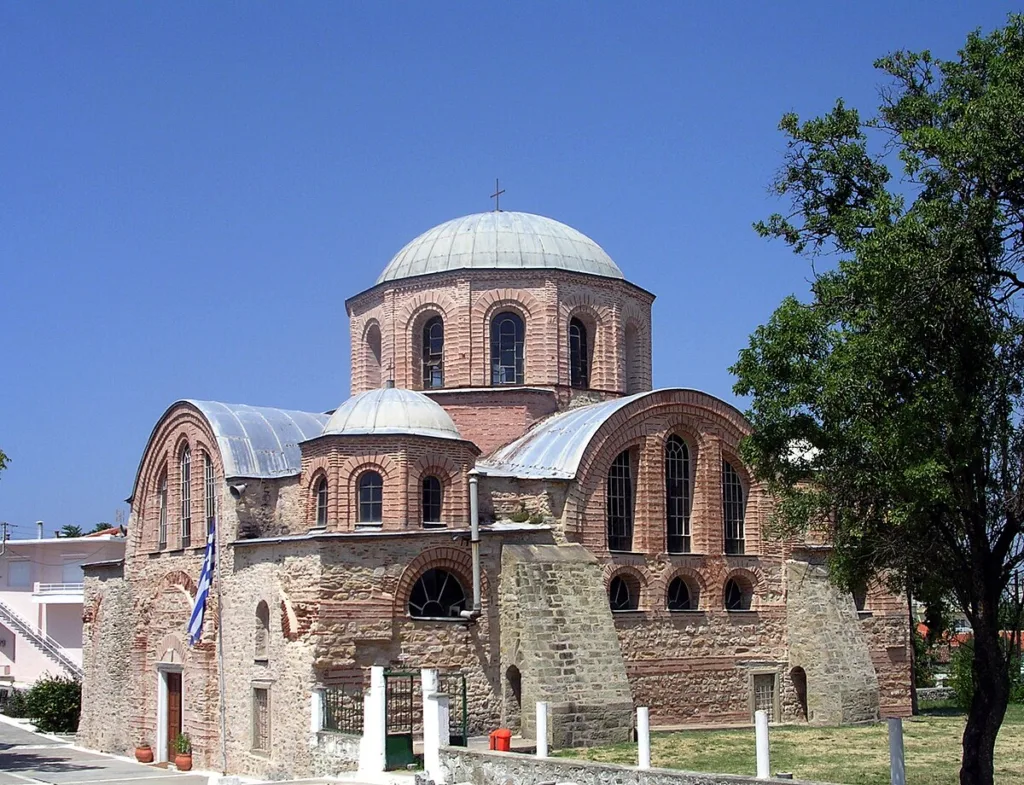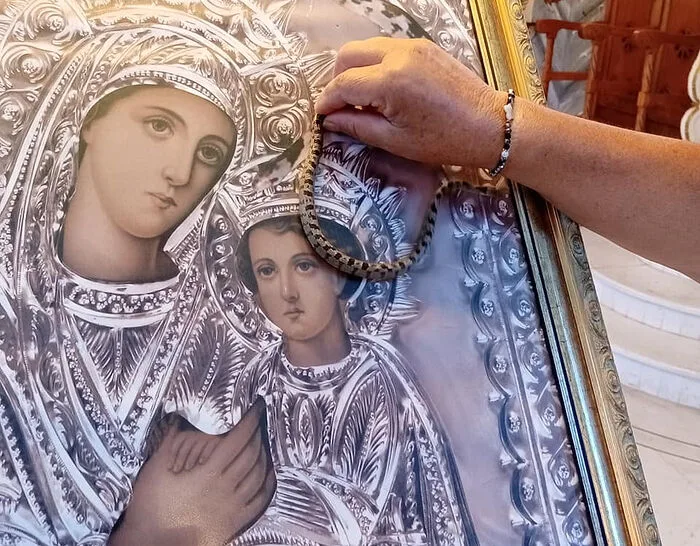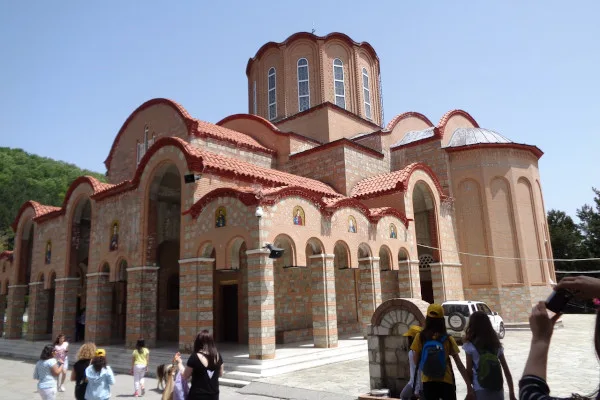By Marina Siskos
The feeling is ignited only to the lucky ones that have experienced at least one Dekapentavgousto in Greece. The sense of sacredness is diffuse in every corner of the country, heralding the end of summer, in the characteristic, mild breeze of late August.
Awakenings, traditions, pilgrimages to historic monasteries throughout the country, offers to the Virgin Mary and a 15-day period of Lent, commonly honour the Dormition of Mary.
Some places have tied their name to the uniqueness or the longevity of their celebration of the Dormition of Mary.
Panayia of Kosmosoteira, Ferai, Evros: Liturgy at the Trinational Point of Evros

Constructed on the strategically unique position atop a hill trespassing via Egnatia, close to Evros river, the church of Kosmosoteira, in the traditional Ferai settlement (district of Thrace), is an outstanding monument of the mid-Byzantine period. The monastery has been founded by the emperor Isaac Komnenos in 1152.
Over the recent years, the monastery is under extensive preservation and restoration, which has transferred the liturgy of the Dormition outdoors in the vast church yard, offering a breathtaking, clear view of the Evros river and the neighbouring villages of Turkey.
The combination of the scenery, the historicity of the place and the sacredness of the day, combine to create a thrilling experience, revived by locals and visitors every year.
Kozani, village of Siatista: The Horsemen’s Custom; Pilgrimage
This is a tradition that casts back to the days of the Ottoman occupation. At some point during the Ottoman occupation, the rulers granted to the occupied Greeks the right to honour the day of the Dormition and this was thereupon celebrated in the most venerable way, even only for a day.
After all, the collective, religious celebration was a reminder of their identity and it kept their wish for liberation alive.
The miraculous icon of Virgin Mary, kept in the homonym monastery of the village Mikrokastro (namely: small castle) during the litany, the ritualistic procession is carried by the pilgrims, mounted on their tastefully adorned horses. The sacred icon is kept in this monastery since 1603.
The embellished and long-prepared horses of the march are the highlight of the celebration, coupled with the traditional music, dance and food, all the long way up to the monastery.
Kefalonia, Markopoulo: The Snakes of Virgin Mary

An eerie, unique spectacle is observed in the Markopoulos settlement of Kefalonia island. The spectacle attracts masses of believers. The story, or the myth, of the small, harmless snakes of Panayia of Fidous (Virgin Mary of the snakes) traces back to a time when pirates threatened to invade the island and plunder the monastery.
The nuns then resorted to prayers, summoning for their salvation and the monastery’s safety. The snakes are reputed to be the God-sent salvation of the defenseless nuns against the pirates, notes Kastellariou (2018).
Thereupon, every year, on August 15, the iconic and innocent snakes peek out of the bell tower, making their way to the churchyard and the interior of the monastery, to startle the visitors and, as the folk belief goes, also bring good luck and well-being to the entire island.
Kastanies, Monastery of Panayia Soumela, Imathia: Honouring the Pontiac Orthodox past

Prior to the fateful expatriation and the forced departure, in 1922, of millions of people of the Orthodox population of Pontus, instigated by the movement of the Young Turks, two monks from the monastery of Panayia Soumela concealed in a chest, the holy icon of Panayia, a priceless cross crafted with a piece of the True Cross, owned by Manuel Konmenos the III, and a manuscript of the Holy Gospel, owned by Saint Christophorus.
They buried the chest in the chapel yard of Saint Barbara. It was in 1931, upon initiative of the Prime Minister of the time, Eleftherios Venizelos, that one of the monks, pater Amvrosios, was sent back to Pontus to unearth and recover the sacred heirlooms, which he brought back to Greece. 1951 marks the year of the construction of the new Panayia Soumela, in Vermio, Imathia district.
The foundation of the new monastery was upon initiative of Filon Ktenidis (Trabzon, 1889-Thessaloniki, 1963). The monastery is a direct symbolic reference to the original one and it enshrines the historic icon of Panayia Soumela that was brought back from Pontus, accompanied by the sacred heirlooms.
Every year in Dekapentavgoustos, the holy site is flooded with thousands of pilgrims arriving from every part of the country and abroad who arrive to honour the Dormition of Virgin Mary and observe the celebrations.
Besides being a bank holyday and one of the most glorious religious celebrations, August 15, Dekapentavgoustos or the Koimisis of Theotokos (the Dormition of Virgin Mary), is also a name day to many Greek people, therefore a family celebration, as, most probably, there is at least one member named after Panayia in a Greek family.
Wish them a happy name day if you happen to be close to a Panos, Panayiotis, Panayiota, Yiota, Mary, Maria, Mario, Despoina or Despo!
References:
- Τα έθιμα του Δεκαπενταύγουστου στην Ελλάδα. YouTube. Uploaded by EΡΤ Α.Ε. Uploaded 15/08/21. https://youtu.be/DGsOTpYxyyM.
- Καλτσίδη, Μ. (2022). Σιάτιστα Κοζάνης: Αναβίωσε το Έθιμο των Καβαλάρηδων. ERT News.
- Kastelloriou, S. (2018). Η Σημερινή ημέρα της Κοιμήσεως της Θεοτόκου, αποτελεί μία από τις μεγαλύτερες γιορτές της ορθοδοξίας, γνωστή και ως το Πάσχα του Καλοκαιριού. SBS Ελληνικά.
- Law and Order Newsroom. (2022). Πώς Ξεκίνησε το Έθιμο των Καβαλάρηδων από τη Σιάτιστα Κοζάνης. Πώς ξεκίνησε το έθιμο των καβαλάρηδων από τη Σιάτιστα Κοζάνης – Law & Order (lawandorder.gr)
